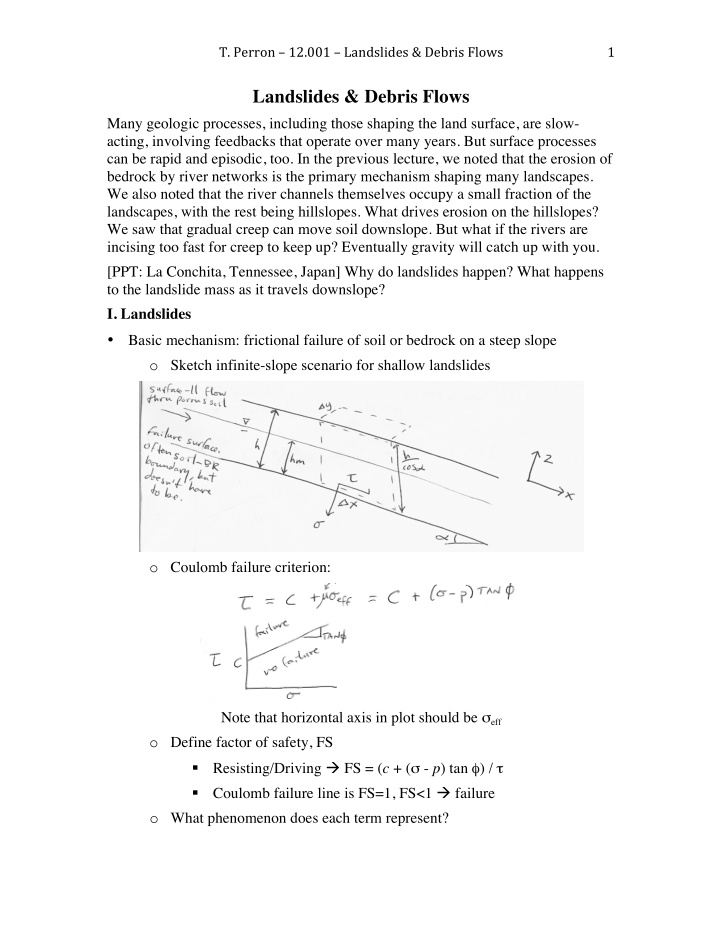



T.#Perron#–#12.001#–#Landslides#&#Debris#Flows# 1# Landslides & Debris Flows Many geologic processes, including those shaping the land surface, are slow- acting, involving feedbacks that operate over many years. But surface processes can be rapid and episodic, too. In the previous lecture, we noted that the erosion of bedrock by river networks is the primary mechanism shaping many landscapes. We also noted that the river channels themselves occupy a small fraction of the landscapes, with the rest being hillslopes. What drives erosion on the hillslopes? We saw that gradual creep can move soil downslope. But what if the rivers are incising too fast for creep to keep up? Eventually gravity will catch up with you. [PPT: La Conchita, Tennessee, Japan] Why do landslides happen? What happens to the landslide mass as it travels downslope? I. Landslides • Basic mechanism: frictional failure of soil or bedrock on a steep slope o Sketch infinite-slope scenario for shallow landslides o Coulomb failure criterion: Note that horizontal axis in plot should be σ eff o Define factor of safety, FS ! Resisting/Driving " FS = ( c + ( σ - p ) tan φ ) / τ ! Coulomb failure line is FS=1, FS<1 " failure o What phenomenon does each term represent?
T.#Perron#–#12.001#–#Landslides#&#Debris#Flows# 2# ! c = cohesion due to surface tension, tree roots, clays ! σ = normal stress due to slope-normal component of weight ! p = water pressure due to subsurface flow ! φ = internal friction angle ! τ = shear stress due to downslope component of weight o Why do landslides happen in steep terrain? ! Both σ and τ arise from weight of the soil ! As slope steepens, τ increases and σ decreases " equivalent to moving toward upper left of Coulomb plot o Why do landslides happen when it rains? ! Increases p " decreases σ eff , and therefore friction. Note that subtracting p from σ shifts the stress state to the left, so for a given σ , less τ is required to cause failure ! Need to predict subsurface flow to get p . o What else about the topography influences where landslides occur? ! Topography influences subsurface flow paths… • Hydrologic model Steady-state drainage basin mass balance o
T.#Perron# –#12.001# –#La ndslides# &# Debris# Flow s# 3# o Steady-st ate subsurface flow based on D arcy’s law (onl y sketch Δ z and Δ l ), and use z instead of h (we use h for soil thickness above) This gives us Q = VA = - KA d z /d l = qa . What is A ? A = hmb " qa = - Khmb d z /d l So the saturation level that determines p is hm = q a / b / (- K d z /d l ), where • K is a measure of how easily water moves through the soil • q is a measure of recharge (closely related to precip) • a / b is a measure of convergence of the topography • d z /d l is a measure of slope, assuming surface-parallel flow o This is why landslides usually happen in valleys: topography focuses subsurface flow " lower effective σ • What are we neglecting with the infinite slope analysis? o Normal forces from upslope and downslope boundaries o Sidewall friction o Cohesion on upslope, downslope and lateral boundaries
T.#Perron#–#12.001#–#Landslides#&#Debris#Flows# 4# o Time-dependent hydrology & rheology • But it is often an acceptable approximation for shallow landslides that are much wider and longer than they are deep II. Debris Flows • Initiation: What happens when a landslide starts to move? o Some travel a short distance and stop due to increased FS o More commonly, slide starts to behave like a fluid after traveling a few meters. o Result: milkshake of H 2 O, sediment, and other debris that undergoes rapid internal shear, behaves in bulk like a fluid, and travels ~10 ± 5 m/s o Why? ! Collapse of granular structure " elevated pore pressure ! Rheology: strength decreases as stress or strain rate increases • Anatomy • How do we study debris flows? o Occasional observation [PPT: Illgraben video] o Evidence from aftermath (deposits, channel) o Theoretical models (difficult, lots of simplifications) o Experiments ! Literal, field scale: [PPT: Iverson movie] ! Abstracted, scaled-down: [PPT: Hsu movies]. • Note separation into snout and tail, recirculation
MIT OpenCourseWare http://ocw.mit.edu 12.001 Introduction to Geology Fall 2013 For information about citing these materials or our Terms of Use, visit: http://ocw.mit.edu/terms.
Recommend
More recommend